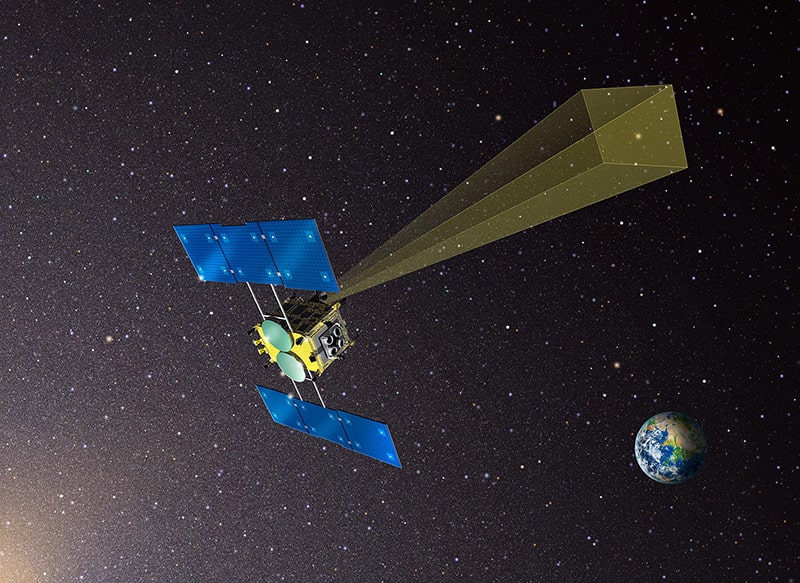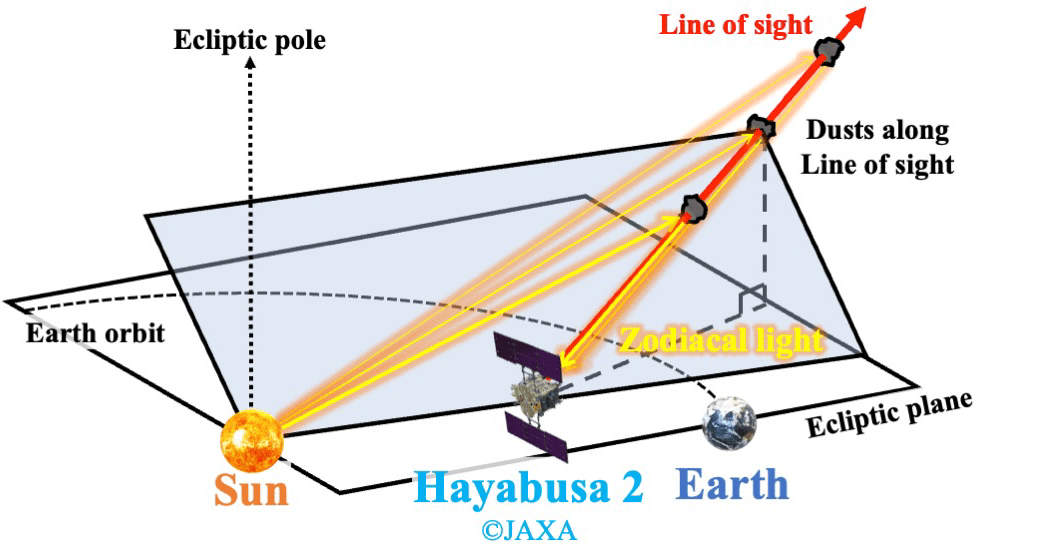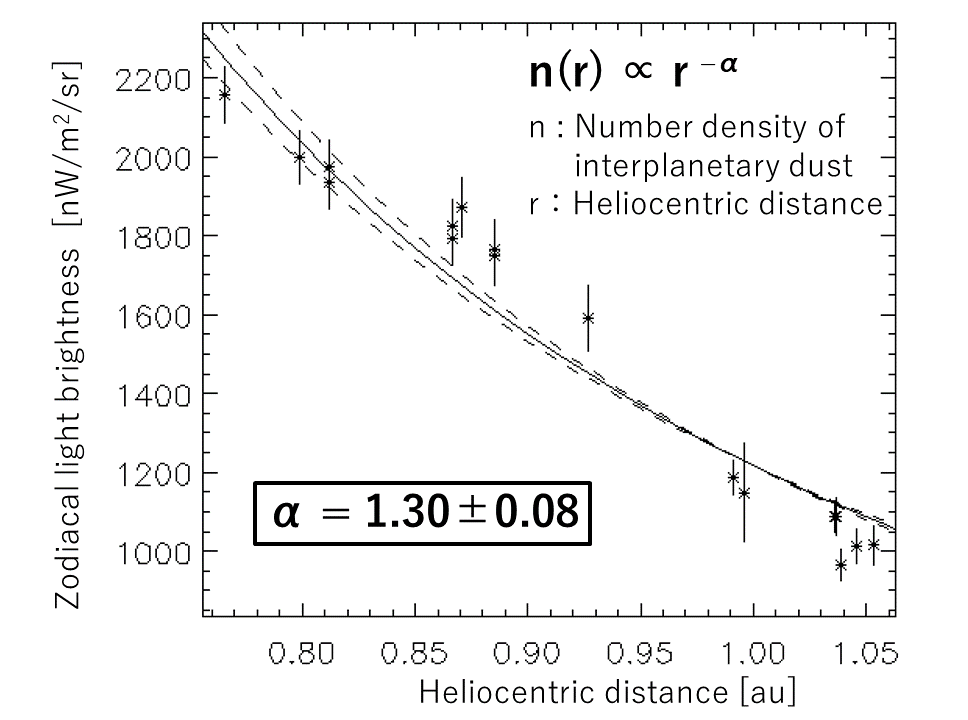Detection of dust distribution in the solar system by Hayabusa2# ~ First result in almost half a century since NASA's spacecraft observed ~
Aug. 22, 2023 | GATEWAY to Academic Articles

The distribution of interplanetary dust in the inner planetary region was measured through the zodiacal light observations, conducted during the Hayabusa2 extended mission (Hayabusa2#) to other asteroids after its return to Earth on December 6, 2020 (Fig.1). Interplanetary dust is the smallest object in the solar system, and exploring where they formed and how they are distributed in the solar system is important to the evolutionary history of the solar system. This result was achieved by long-term observation of the zodiacal light using the optical camera (ONC-T) onboard the Hayabusa2 spacecraft in interplanetary space, and succeeded in obtaining information on the distribution of interplanetary dust, which could not be obtained by the zodiacal light observation from near-Earth. This is the first achievement in about half a century since the NASA spacecraft observed the zodiacal light in the 1970s. Compared to those days, the performance of instruments has improved dramatically, and analysis methods have become more sophisticated.
Research Summary

Zodiacal light*1 is a faint light produced when sunlight is scattered by interplanetary dust*2 in our solar system (Fig.2). Interplanetary dust is the smallest object in the solar system, and we can explore the dynamic changes in the solar system from a different aspect than the study of planets and asteroids by exploring where interplanetary dust forms and how it moves in the solar system through the zodiacal light observations. In this study, the zodiacal light observations by ONC-T onboard Hayabusa2# between 2021 and 2022 in the range of 0.76 to 1.06 au of heliocentric distance*3 were successful (Fig.3), providing information on the distribution of interplanetary dust in the inner region of the solar system. This observation clearly shows that the number density of interplanetary dust in the vicinity of the Earth follows a power law*4 (Fig.4). The obtained power law index indicates that the closer to the Sun, the more dense the interplanetary dust becomes than predicted, compared to the standard theory that only considers the fall of interplanetary dust to the Sun. This result suggests that either there is new physics for the fall of interplanetary dust to the Sun or that there is an unknown astronomical phenomenon that produces dust in the vicinity of the Earth. This information could not be obtained by the zodiacal light observation from the near-Earth region, and this achievement was made possible by Hayabusa2# cruising in interplanetary space. This is the first achievement in about half a century since NASA's Pioneer 10 and 11 and Helios A and B spacecraft observed the zodiacal light in the 1970s, but the performance of instruments has improved dramatically since then, and analysis methods have also become more sophisticated.

This result is the first scientific achievement of the Hayabusa2#. While most conventional planetary exploration missions preserve their instruments until the spacecraft arrives at the target object, Japanese planetary probes such as Nozomi, IKAROS, and EQUULEUS have conducted "cruising science", and this result is another example of such a new approach. In particular, the Hayabusa2 probe was utilized as an "astronomical observatory flying in interplanetary space" overcoming engineering constraints to realize astronomical observations. This achievement symbolizes Japanese space science as an interdisciplinary collaboration among astronomy, planetary science, and space engineering.

Based on this result, the zodiacal light observations by the Hayabusa2 spacecraft will continue in the future. Especially after the Earth swing-by scheduled in 2028, we aim to realize the zodiacal light observations outside the Earth's orbit (in the range of 1-1.5 au). Furthermore, we are considering conducting zodiacal light observations by future planetary exploration missions.
The results will be useful not only for studying interplanetary dust, but also for observing the faint extragalactic background light originating from the distant galaxies in the early universe, which is buried in the zodiacal light. Our international research team plans to make more detailed observations of the zodiacal light and the extragalactic background light with the NASA’s sounding-rocket experiment CIBER-2, scheduled for launch in the winter of 2023, and future planetary probes.
Terminologies
- *1 zodiacal light : Zodiacal light is diffuse brightness caused by scattered sunlight by interplanetary dust floating in the solar system. In some of the darkest places on earth, it is possible to see the zodiacal light with the naked eye after sunset or before sunrise.
- *2 interplanetary dust : Dust floating in the solar system, ejected into space by collisions between asteroids and ejections from comets. It is estimated that 100 tons of interplanetary dust is falling to the earth every day.
- *3 heliocentric distance : The distance from the Sun. The unit is generally the au (astronomical unit), derived from the average distance between the Earth and the Sun. 1 au = 149,597,870,700 m (about 93 million miles)
- *4 power law : A relationship in which one observed quantity is proportional to a power of another observed quantity. Many natural and social phenomena, including physical laws, can be described by the power law. In this study, it was shown that the number density of interplanetary dust, n, follows the power law of the heliocentric distance, r, i.e., n(r)∝r-α(αis called the power index), and the power index was determined accurately.
Information
| Journal Title | Earth, Planets and Space |
|---|---|
| Full title of the paper | Heliocentric Distance Dependence of Zodiacal Light Observed by Hayabusa2# |
| DOI | 10.1186/s40623-023-01856-x |
| Publish date | 22 August 2023 |
| Author(s) | Kohji Tsumura, Shuji Matsuura, Kei Sano, Takahiro Iwata, Hajime Yano, Kohei Kitazato, Kohji Takimoto, Manabu Yamada, Tomokatsu Morota, Toru Kouyama, Masahiko Hayakawa, Yasuhiro Yokota, Eri Tatsumi, Moe Matsuoka, Naoya Sakatani, Rie Honda, Shingo Kameda, Hidehiko Suzuki, Yuichiro Cho, Kazuo Yoshioka, Kazunori Ogawa, Kei Shirai, Hirotaka Sawada, Seiji Sugita |
| ISAS or JAXA member(s) among author(s) | IWATA Takahiro, YANO Hajime, HAYAKAWA Masahiko, YOKOTA Yasuhiro, SAKATANI Naoya, OGAWA Kazunori, SAWADA Hirotaka |
Links
- Hayabusa2 Extended Mission
- Exploring the mystery of interplanetary dust with the Hayabusa2 optical camera
Author
A word from the co-author at ISAS
Cosmic dust refers to solid microparticles less than 1 mm in diameter that exist in space. It is a unique research subject in space science that can be studied directly with all microscopes, telescopes, and spacecraft. This is an excellent example of interdisciplinary research in space science, where the whole picture is only revealed by integrating meteoritics, astronomy, and space exploration.
The measurement and collection of cosmic dust in the vicinity of the Earth is one of the oldest space science themes, having started immediately after the first human exploration of space. The material analyses of micrometeorites originating from comets and asteroids have contributed to a better understanding of the early Solar System compositions and the processes that delivered water and life precursors to the Earth. The Hayabusa and Hayabusa2 are the first missions that directly visited the origins of cosmic dust and brought back the cosmic dust with geological contexts to Earth. This was a great leap forward from previous meteoritic research, which analyzed cosmic dust collected in the vicinity of the Earth but for which their parent bodies were unknown.
On the other hand, optical and infrared observations of zodiacal light, which is sunlight scattered by cosmic dust in the Solar System, have revealed the structure of the cosmic dust population in the present-day Solar System. The zodiacal light also helps to obtain fundamental information for understanding exoplanetary disks and to calibrate more precisely the astronomical observation data of background stars behind the zodiacal light. The results were obtained through successful observations of the zodiacal light using the optical camera onboard the Hayabusa2 spacecraft during its interplanetary cruising phase. In particular, the structure of cosmic dust distribution inside the orbit of the Earth was only observable in-situ by the spacecraft.
Many may think that spacecraft begins scientific observations only after arrival at the mission target. In fact, however, ISAS planetary missions such as Nozomi, IKAROS, BepiColombo, and EQUULEUS traditionally conducted “cruising science”, which involves continuous observations of the cosmic dust environment or the plasma and magnetic environment, even during their interplanetary cruises, in order to maximize the scientific outcomes of each mission. This time, we have added a new possibility to that lineage: zodiacal light observations.
For space science in the 2020s and beyond, when exploration of distant targets beyond Mars will increase worldwide, such "cruising science" will become increasingly important, as it will be able to produce scientific outcomes early and frequently, even during their long interplanetary cruises before reaching the final target. From this perspective, I believe that this study effectively utilized Hayabusa2's science and engineering dual-use camera for cruising science has shown the world new possibilities for scientific observation in future deep space exploration.


 TSUMURA Kohji / Tokyo City University
TSUMURA Kohji / Tokyo City University
